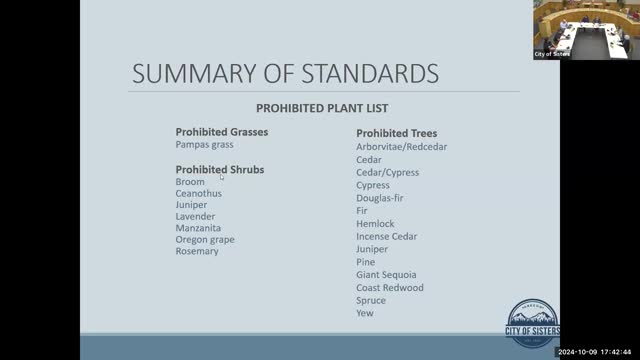New fire safety measures target hazardous vegetation near homes
October 09, 2024 | Sisters, Deschutes County, Oregon
This article was created by AI summarizing key points discussed. AI makes mistakes, so for full details and context, please refer to the video of the full meeting. Please report any errors so we can fix them. Report an error »

In a recent government meeting, officials discussed new fire safety regulations aimed at reducing wildfire risks in residential areas. The proposed measures focus on creating defensible spaces around homes by removing hazardous vegetation and implementing strict guidelines on landscaping.
Key points from the discussion included the removal of all dead and dying plants on properties, with a specific emphasis on eliminating highly flammable vegetation within five feet of structures. New plantings of such vegetation will be prohibited within 30 feet of homes. The regulations also call for the use of non-combustible materials, such as gravel or hardscape, in the critical five-foot zone to prevent fires from spreading to buildings.
The meeting highlighted the importance of adhering to standards set by the Insurance Institute for Business and Home Safety (IBHS), which advocates for stringent fire safety measures. One participant emphasized that maintaining a clear five-foot zone is crucial for preventing ignition from embers, which can travel significant distances during wildfires.
Concerns were raised about the practicality of these regulations, particularly for homeowners with existing landscaping. Some participants noted that while the fire department conducts assessments and makes recommendations, they currently lack enforcement authority. This has led to questions about how to balance fire safety with the realities of maintaining a home and garden.
The discussion also touched on the broader implications of these regulations for insurance coverage, as many homeowners face challenges with insurers withdrawing policies in high-risk areas. By adopting IBHS standards, officials believe they can strengthen their position with insurance companies and provide homeowners with clearer guidelines.
As the city moves forward with these proposals, it aims to set a precedent in Central Oregon for fire safety regulations, with other cities and homeowners associations in the region closely monitoring the developments. The meeting concluded with a call for further consideration of the proposed measures, ensuring they are both effective and practical for residents.
Key points from the discussion included the removal of all dead and dying plants on properties, with a specific emphasis on eliminating highly flammable vegetation within five feet of structures. New plantings of such vegetation will be prohibited within 30 feet of homes. The regulations also call for the use of non-combustible materials, such as gravel or hardscape, in the critical five-foot zone to prevent fires from spreading to buildings.
The meeting highlighted the importance of adhering to standards set by the Insurance Institute for Business and Home Safety (IBHS), which advocates for stringent fire safety measures. One participant emphasized that maintaining a clear five-foot zone is crucial for preventing ignition from embers, which can travel significant distances during wildfires.
Concerns were raised about the practicality of these regulations, particularly for homeowners with existing landscaping. Some participants noted that while the fire department conducts assessments and makes recommendations, they currently lack enforcement authority. This has led to questions about how to balance fire safety with the realities of maintaining a home and garden.
The discussion also touched on the broader implications of these regulations for insurance coverage, as many homeowners face challenges with insurers withdrawing policies in high-risk areas. By adopting IBHS standards, officials believe they can strengthen their position with insurance companies and provide homeowners with clearer guidelines.
As the city moves forward with these proposals, it aims to set a precedent in Central Oregon for fire safety regulations, with other cities and homeowners associations in the region closely monitoring the developments. The meeting concluded with a call for further consideration of the proposed measures, ensuring they are both effective and practical for residents.
View full meeting
This article is based on a recent meeting—watch the full video and explore the complete transcript for deeper insights into the discussion.
View full meeting
